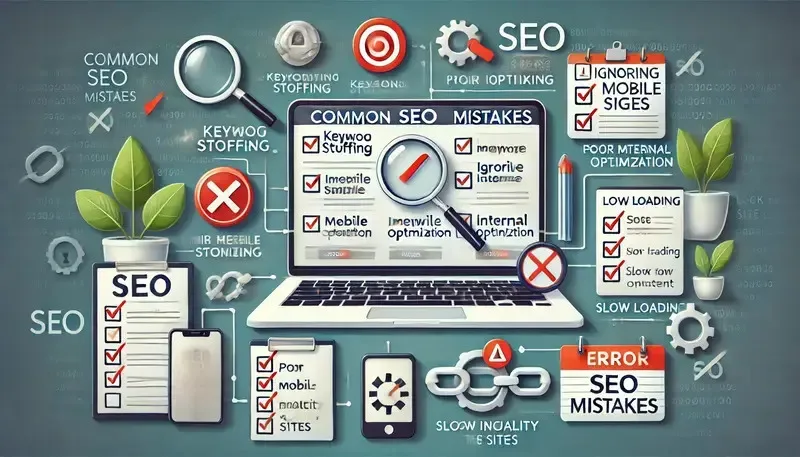Frequent Mistakes in SEO and How to Avoid Them

SEO is essential for enhancing a website’s visibility on search engines. Despite its importance, many practitioners commit several mistakes that compromise their site’s ranking. Understanding and addressing these errors is key to achieving effective SEO. Here, we explore the most common mistakes and how to steer clear of them.
Incorrect Use of Keywords
Mistake: One of the most prevalent mistakes in SEO is the improper use of keywords. This includes keyword stuffing, targeting irrelevant keywords, and neglecting long-tail keywords.
Solution: Conduct thorough keyword research to identify relevant and high-volume keywords that align with your content. Use these keywords naturally within your text, headings, and meta descriptions to avoid keyword stuffing. Additionally, focus on long-tail keywords to capture specific search intents and improve your chances of ranking higher.
Ignoring Mobile Optimization
Mistake: In today’s mobile-first world, neglecting mobile optimization is a significant SEO blunder. Websites that are not mobile-friendly can suffer from higher bounce rates and lower search rankings.
Solution: Ensure your website is responsive and offers a seamless experience across all devices. Use tools like Google’s Mobile-Friendly Test to check your site’s compatibility and make necessary adjustments to improve mobile usability.
Lack of Quality Content
Mistake: Producing low-quality, thin, or duplicated content can severely impact your SEO performance. Search engines prioritize content that is valuable, informative, and engaging for users.
Solution: Focus on creating high-quality content that provides value to your audience. This includes well-researched articles, comprehensive guides, and unique insights that distinguish your site from competitors. Regularly update your content to keep it relevant and informative.
Neglect of Technical SEO
Mistake: Overlooking technical SEO aspects such as site structure, URL optimization, and proper use of tags can hinder your site’s ability to be crawled and indexed by search engines.
Solution: Conduct regular technical SEO audits to identify and fix issues. Ensure your site has a clear structure, uses SEO-friendly URLs, and includes essential tags like title tags, meta descriptions, and header tags. Implement a sitemap and robots.txt file to guide search engine crawlers effectively.

Poor Internal Link Structuring
Mistake: Internal linking helps distribute link equity across your site, but poor internal link structuring can lead to orphaned pages and reduced site authority.
Solution: Develop a strategic internal linking plan that connects related content throughout your site. Use descriptive anchor text and ensure each page is linked to and from other relevant pages. This not only enhances user navigation but also helps search engines understand your site’s hierarchy.
Unoptimized Images
Mistake: Failing to optimize images for SEO can slow down your site and miss out on valuable traffic from image searches.
Solution: Optimize your images by compressing them to reduce file size without compromising quality. Use descriptive, keyword-rich file names and include alt text for each image to improve accessibility and SEO. Also, consider using modern image formats like WebP for better performance.
Slow Loading Site
Mistake: A slow-loading website can frustrate users and negatively impact your search rankings. Page speed is a critical factor in SEO.
Solution: Improve your site’s loading speed by leveraging techniques such as caching, minimizing HTTP requests, and compressing files. Utilize tools like Google PageSpeed Insights to identify and address speed issues. Ensuring fast load times enhances user experience and boosts your SEO efforts.
Lack of Analysis and Monitoring
Mistake: Neglecting to analyze and monitor your SEO performance can prevent you from identifying issues and making data-driven improvements.
Solution: Regularly track your SEO metrics using tools like Google Analytics, Google Search Console, and other SEO software. Monitor key performance indicators (KPIs) such as organic traffic, bounce rate, and keyword rankings. Use this data to refine your SEO strategies and adapt to changes in search engine algorithms.
Avoiding common SEO mistakes requires vigilance and a proactive approach. By addressing these issues, you can enhance your site’s visibility, improve user experience, and achieve better search engine rankings. Remember, SEO is an ongoing process that demands continuous learning and adaptation. Implement these solutions to stay ahead in the competitive digital landscape.
